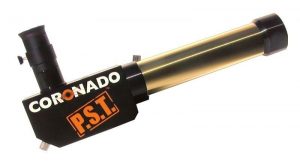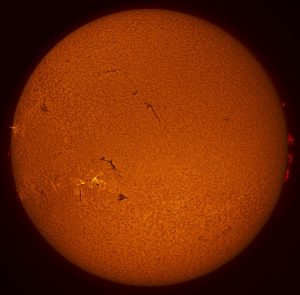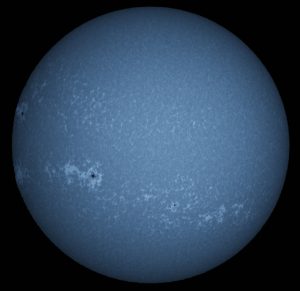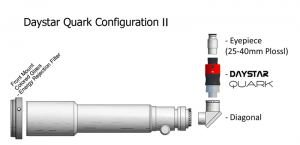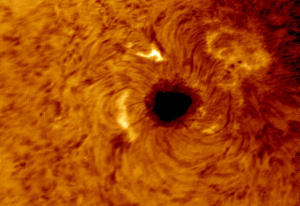Never view the Sun without a suitable Solar Filter! Solar observing is dangerous and can be hazardous to eyesight. Safety is everyone’s responsibility. Never allow people to look through solar telescopes unsupervised and never leave equipment unattended.
This year’s Transit of Mercury has caused great excitement and many are anticipating viewing this pretty rare event. There have been some articles published which say you must never look at the Sun through a telescope but this is not strictly accurate as you can use telescopes to view the Sun and many solar astronomers do very successfully. It is however important that the correct equipment and solar filters are used to observe the Sun. In order to allow you to have a safe and interesting experience, follow the guide below.
Solar Glasses
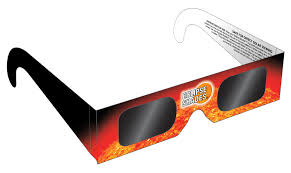
One way to observe the Sun is to use specially designed solar glasses. These usually consist of cardboard frames with special solar film as lenses. While you will be able to pick out larger Sun spots with these glasses, it is unlikely you will see the 12 arcsecond Mercury very well. You can purchase solar glasses here:
baader-solar-eclipse-observing-glasses.html
Solar Projection
A good way to allow groups of people to observe the transit at the same time is to use Solar Projection. To do this you need a piece of white card which is held at the eyepiece end of the telescope. You will need a pair of binoculars or a small telescope, a piece of plain cardboard about 30 centimeters square for the “collar,” and a second piece of white cardboard (or paper) at least 10 centimeters square for the screen. If you use a telescope, you should mount it on a tripod. If you use binoculars, you can hold them in your hand, but it is much more convenient (and you will have a steadier image) if you improvise some sort of stand or tripod to hold them. Point the binoculars or telescope at the Sun (do not look through the instrument to do this!), as shown in the figure, and adjust the direction of pointing until the image of the Sun appears on the screen. (This may take a minute or two.) One useful trick is to watch the shadow of the binoculars or telescope tube: if pointed directly toward the Sun, then the sides of the tube will cast no shadows, and the instrument’s shadow will be as small as it can be.) Move the screen toward or away from the eyepiece until the image of the Sun fits neatly in the middle. and adjust its tilt until the Sun’s image is circular. Note that leaving the telescope pointing at the Sun for too long may result in the glass lense cracking.
White Light Filters
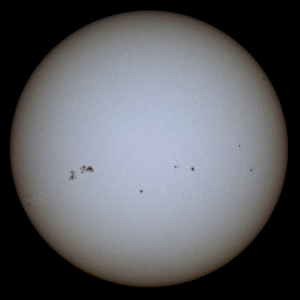 Image Credit: Steve Wainright
Image Credit: Steve Wainright
If you already have a telescope or binoculars you can use special “white light” solar filters to view the Sun. These filters are made from very thin Mylar which has a special coating and they reduce the energy of the Sun by more than 99%. White light filters do exactly what it says on the tin, they show the Sun in its natural colour, white. You will easily see sunspots and Mercury but you will not see much surface detail. This type of filter fits over the front of the telescope, binoculars or camera lenses and should be carefully secured to avoid the chance of them falling off and causing permanent eye damage. You can buy ready made solar filters or buy solar film and make your own.
Baader Solar Film
White Light Filters
Solar Wedges
Solar Wedges are an inexpensive way to observe the Sun in white light but you do need a suitable telescope. These devices are designed to be used on refractor telescopes and should never be used with reflecting or Newtonian scopes and it is advisable to use a neutral density filter. The wedges fit at the eyepiece and of the telescope and you will need to insert an eyepiece to view.
Herschel Solar wedge
Solar telescopes
The most expensive way to observe the Sun is to use a specially designed solar telescope. Various manufactures make different scopes which retail at anything from a few hundred pounds to many thousands. These telescopes filter the light from the Sun at different wavelengths, the most popular being Hydrogen Alpha (Ha) and Calcium K (Ca-K). With this type of telescope you can observe not only sunspots but amazing surface detail, prominences and flares. This is probaly the most exciting way to watch what is going on with our star and the detail can be excellent.
Quark filters
A fairly new device on the market is the Quark solar eyepiece. This is a solar filter device that is placed between the telescope diagonal and the eyepiece. They provide a fantastic way to use your existing scope as a special Hydrogen Alpha or Calcium K telescope. They are now available for refractor and SCT telescopes and are a cost effective way of getting into advanced solar observing and imaging. Quark Solar Filters
This is just a quick overview of some of the ways to view the Transit of Mercury safely. There are of course many different specialist telescopes and filters available but please remember that you should NEVER view the Sun directly or through a telescope, camera or binoculars without the correct filter!
John Maclean
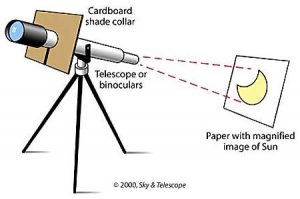
![lunt-2in-white-light-herschel-wedge-solar-wedge-[2]-5050-p](https://www.exeterobservatory.com/wp-content/uploads/2016/04/lunt-2in-white-light-herschel-wedge-solar-wedge-2-5050-p-300x200.jpg)
